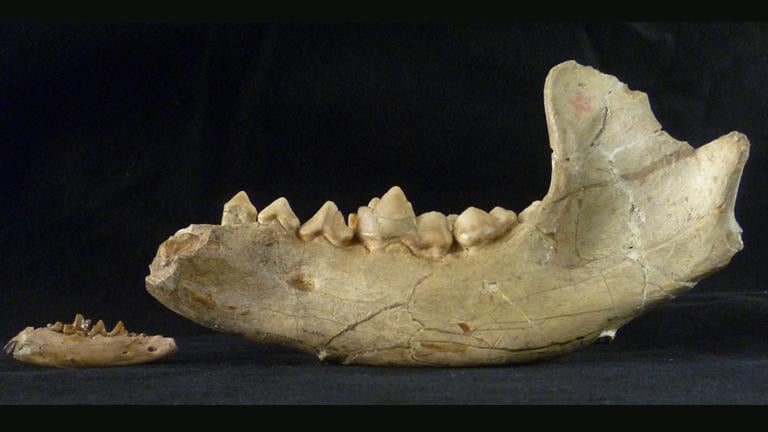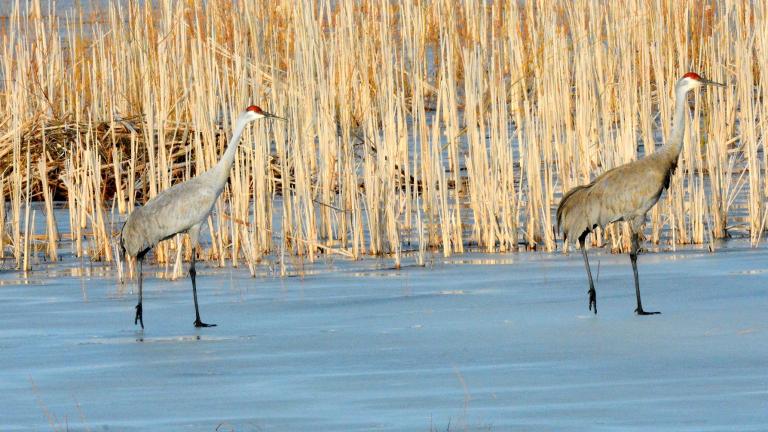“The act of smelling something, anything, is remarkably like the act of thinking itself.”
That quote from doctor and essayist Lewis Thomas is featured in the pages of a new book on the powerful noses of dogs.
For dogs, there are no good or bad smells; just an influx of information with each inhale. So writes dog cognition expert Alexandra Horowitz, whose newly published book is called “Being a Dog: Following the Dog Into a World of Smell.”
Horowitz joins Chicago Tonight for a conversation about her work. She's head of the Dog Cognition Lab at Barnard College, and previously wrote the New York Times bestseller “Inside of a Dog.”
Below, an excerpt from “Being a Dog: Following the Dog Into a World of Smell.”
1: Nose of a Dog
Finnegan’s is ebony-black, moist, and dappled, two cavernous bass clefs at its front. Upton’s is cleft with a visible valley, the whole thing guarded by short whiskers standing at attention.
These are my dogs, and these are my dogs’ noses.
Before I became a research scientist studying dog cognition, I didn’t think much about the dog nose. It may have been frowned at when poking impolitely at the privates of visitors to my home, or dabbed with peanut butter to encourage the swallowing of a pill. Even then, though, little regard was given to the nose itself—to its form, to its movement, to the impossibly convoluted and complex vault it opens into.
This oversight isn’t restricted to dog noses. We rarely study the nose on each other’s face. At the nose prominently displayed—indeed, jutting out, leading the way for the rest of the body. Without looking, try to describe your partner’s nose, or your mother’s. If it’s not beakish or buttony, well, it’s just a nose. Two nostrils dangling from a squashed, fleshy tetrahedron.
I gaze at my son’s nose, but mostly at its surface—where the freckles have begun to assemble on his fair skin. But the snout of the dog gets my full attention. Now I look at dogs nose-first. For I am besotted with dogs, and to know a dog is to be interested in what it’s like to be a dog. And that all begins with the nose.
What the dog sees and knows comes through his nose, and the information that every dog—the tracking dog, of course, but also the dog lying next to you, snoring, on the couch—has about the world based on smell is unthinkably rich. It is rich in a way we humans once knew about, once acted on, but have since neglected.
By smelling, tapping into this sensory resource that we have but that we largely ignore, the dog has become an informant. Working dogs, trained to tell us what they naturally know, detect the presence of illegal substances and unwanted pests. But the dog also knows about the upcoming weather, the way afternoon smells, and whether you are sick or upset. Every inhaled gulp of air is full of information. It holds the odors of people who have recently passed by, leaving olfactory trails in their wake. It catches pollens and plant notes carried on the breeze. Each noseful captures the traces of animals who have walked, run, cowered, eaten, or died nearby. It traps the electric charge and round humid molecules from distant rainstorms.
![]()
What is it like to smell the world with that amazing nose leading the dog through his days?
This book is an exploration of what the dog’s nose knows as has never been done before. What does your dog smell on you, on the ground, or with his nose deep in the fur of another dog? What does he know about you—that you might not know yourself? What is it like to smell the world with that amazing nose leading the dog through his days?
To find out, I tracked the tracking dogs. Over the last years I have watched detection dogs grow up, be trained, and find their quarry, be it drugs, food, or people. With my Dog Cognition Lab at Barnard College, I have researched the pet dog’s experience of himself, other dogs, and the smells of the human world in which he lives. I have spoken to scientists who study and model the dog nose, and to trainers and handlers who follow it. It is an examination of all aspects of the dog’s olfactory world, and the magnificent organ that leads to it.
But it is also an exploration of the noses on our faces. We have untrained ourselves, we humans—unlearned how to smell, over millennia. We are out of the habit of smelling. Why, you may not even have smelled this book yet, though it is but inches from your face. I find people who are smelling, and practice their methods.
Having myself committed a lifetime of not smelling, I let my dogs’ behavior counsel me: I have ventured to be a little more like a dog myself. In my book Inside of a Dog I began an imaginative leap into what it might be like to be a dog—and here I leap with four feet. I try to take my nose to the places the dog nose goes. And I sniff.
I begin this process by learning more about our own sense of smell. And then I train my nose to better conjure what it might be like to have the mind and nose of a dog.
My inspiration and guides are our family’s own dogs, Finnegan and Upton. Both are highly charismatic mutts. My husband and I met Finnegan’s nose through the bars of a crate at a shelter that imports unwanted dogs from the South. He was four months old, had had ringworm and parvovirus, and, though recovering, was skinny and a bit sickly. I should say that I don’t go to shelters much, because when I do, I inevitably walk out with a new animal. When I first saw him, in that crate at eye level, he wagged mightily, accepted a finger poked through the bars for licking, poked his nose through reciprocally, and then, as we moved on, sat down patiently. I looked back at him often: he was sitting and . . . waiting. We took him out of the crate to meet him, and he moved between my husband and me, looking at each of us in the face. Weary, he leaned against me. That was that. We took him home.
Finn is now eight years older. He still has the look of that puppy who leaned. While his coat is a glossy black, as though we polish him daily, it is his way of looking that most captures him. One gets the feeling that he is always aware of what is happening. His eyes penetrate us. They follow us, they check with us when another animal is misbehaving, they look to us dolefully when we head out the door. Ears back, eyes full, he is hard to leave. He does not look simply with his eyes: his nose examines us. When we return home, he sniffs us, as close as we will let him, in an exploration of where we’ve gone, what we’ve eaten, whom we’ve touched or pet. Never have I returned home, having met a dog on the street, and escaped Finn’s examination.

I tend to think of Finn as a “professional dog.” He is eminently civilized: without our explicitly teaching him, he fell into line with what we expect from a dog in the house. He swallowed the little culture of our family whole. Upton, by contrast, whom we met three years into his life, is feral by comparison. He had been relinquished to the shelter from which he was initially adopted three years prior. We’ve seen his first photos: a small-bodied hound, ears too large for his head. Nose a blur. Well, his head and body grew up: he’s a large, brindle, hound mix, with full eyes and a corkscrew tail.
Whiskers punctuate his snout; his jowls droop. He is a dog’s dog, incurably friendly with any dog, and has a gangly, goofy run. There is no photo of Upton in which he looks streamlined, athletic, or svelte. In running, his jowls flap, he tilts, his ears go akimbo. He is generously silly. Alas, he was also not a city dog before we knew him, and he is easily startled by every and any sound—car door, garbage truck, garage door opening, street sign shaking in the wind, jackhammer, a bag flapping in a tree, a person suddenly appearing from around the corner . . . you name it. For this reason, while I have followed both of their noses to whatever sundry and sordid spots they’re smelling, it is only Finn who I bring out to do new investigative smelling work. He could half write this book himself.
Take a breath (through the nose, please). We are going on a journey through scents and smelling, with a tour through the improbable science about the olfactory abilities of the dog— and the abilities of our own noses, waiting for us to discover them. By following the dog’s lead, we can learn from him about what we are missing—some of which is beyond our ability to sense, and some of which we simply need a guide to see. The world abounds with aromas, but we are spectacle-less. The dog can serve as our spectacles.
In so doing, we may also see how to return to that perhaps more primal, so-called animal state of knowledge about ourselves and the world that we have forgotten in a culture wrought of technology and lab tests. To follow animals is to become more attuned to our own existence. To follow dogs is to begin to apprehend the experience of our silent, loyal partners through our days.
Excerpted from BEING A DOG by Alexandra Horowitz. Copyright © 2016 by Alexandra Horowitz. Reprinted with permission of Scribner, a Division of Simon & Schuster, Inc.
![]()
Related stories:
 DePaul Professor Discovers New Prehistoric Shark
DePaul Professor Discovers New Prehistoric Shark
Oct. 20: About 20 million years ago a 13-foot predator swam in warm, shallow seas across the globe. This extinct shark was recently discovered by an international team of researchers led by a DePaul University professor.
 Field Museum Fossil Identified as Early Relative of Dogs, Bears
Field Museum Fossil Identified as Early Relative of Dogs, Bears
Oct. 14: Thanks to an inquisitive Field Museum researcher, a nearly 40-million-year-old fossil housed at the institution has been identified as one of the earliest relatives of dogs, bears and foxes known as a beardog.
 Why the Mysterious, ‘Beautiful’ Bat is So Often Misunderstood
Why the Mysterious, ‘Beautiful’ Bat is So Often Misunderstood
Oct. 13: In Chicago and surrounding counties, where reports of nearly 40 cases of rabies-infected bats have made headlines so far this year, the reputation of the small, winged creature seems bleak.









